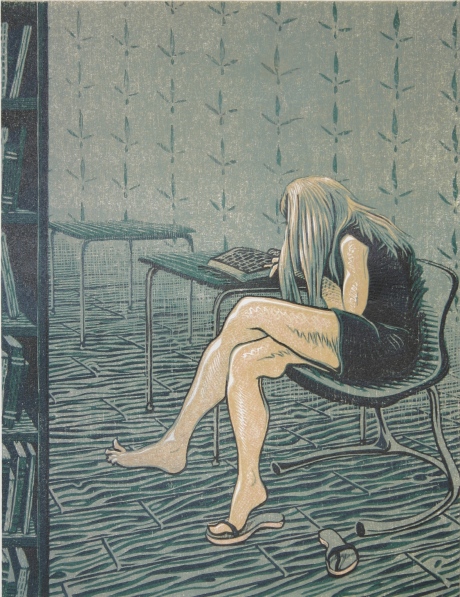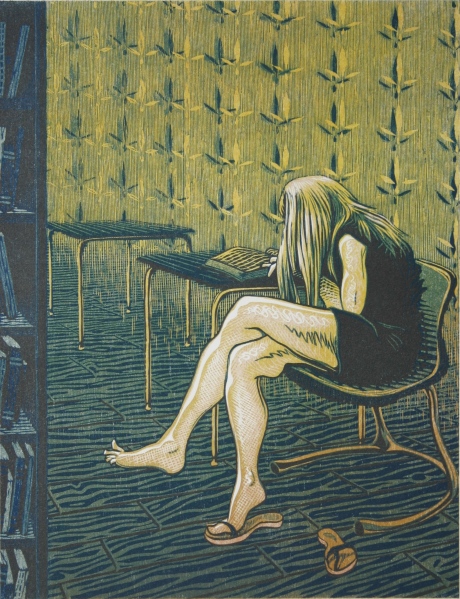
7-layer Reduction Woodcut
13 x 10 inches

7-layer Reduction Woodcut
13 x 10 inches
We become familiar with light’s properties and manners through our eyes, which act as optics. Optics are material instruments (such as mirrors and lenses) used to reflect, refract, and focus complexes of light so that they can be understood in particular ways.
Optics may be organic or inorganic, natural or man-made. Spiders have simple eyes, which are designed to detect various intensities of light and no more. Some nightlights have similar sensors that merely detect light intensity. The sensor operates a switch to turn the nightlight on whenever the room becomes dark. Such nightlights do not need the more sophisticated (and more expensive) optics of SLR (Single Lens Reflex) cameras, which in turn are simple compared to the optics of human eyes.
Complex eyes (such as you are using to read this text) are designed to detect motion, perceive form and space, and distinguish among wavelengths within a narrow range of the electromagnetic spectrum scientists call visible light. Artists call this portion color.
Human eyes have been created to perform all these optical feats well, but are, by design, not the best at any one of them. Nor is every human eye created equal. But in every case, whatever one’s eyes take in his or her brain receives and processes. It is the mind that deciphers perceptions, organizes and compares them, understands them cumulatively, and stores them as memories. Thus, the eyes and the mind each have a particular impact on perception of light.
In the same way, optics and photosensitive mediums impact photographic composition and photographic representations of light.
Optics mediate light before the light is recorded photographically (in most cases). Whenever this is the case, the peculiar logic of the mediating optic(s) pervades the record:
When a camera with a 55 mm lens records light, the logic of the optic is so similar to that of the lenses of human eyes, the result seems natural to us and we do not attend to the present optical logic. But when the optic of a photographic instrument is significantly different than our organic lenses, as in a fisheye lens, the result seems foreign, yet logical.
To be continued…

5-layer Reduction Woodcut
13 x 10 inches
Drawings look drawn. Even the most careful attempts at photographic representation will betray themselves upon full scrutiny. This reality—that a product is a product of, that the end becomes by means—displays itself in visual qualities. A drawing has drawn physical characteristics. If drawn qualities are desirable, the printmaker must elect to do one or more of the following:
When an artist renders from observation, the drawing that results is a unique record of the artist’s motions. If she is drawing from observation, her motions are an effort to depict her perception. Or perhaps she is drawing from her imagination (which is informed by her perceptions). Or perhaps she is drawing as a form of dance, responding to some degree to her perception of her partner (the surface that receives her drawing). Because we have unique bodies and sets of motor memories, and because we have idiomatic perceptions, no two people will produce the same drawing. In fact, a person cannot even redraw a drawing of his own, which is one reason the world needs printmaking, right!